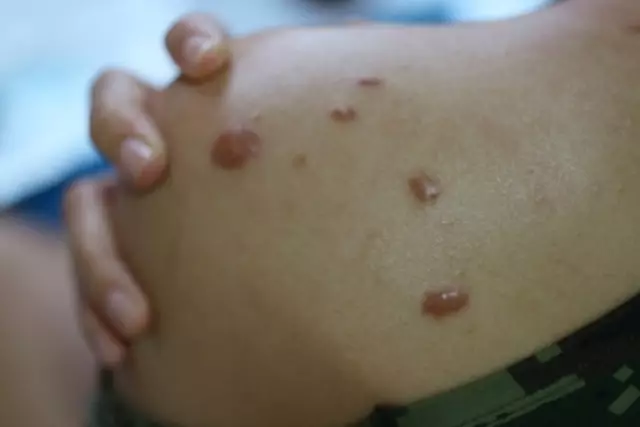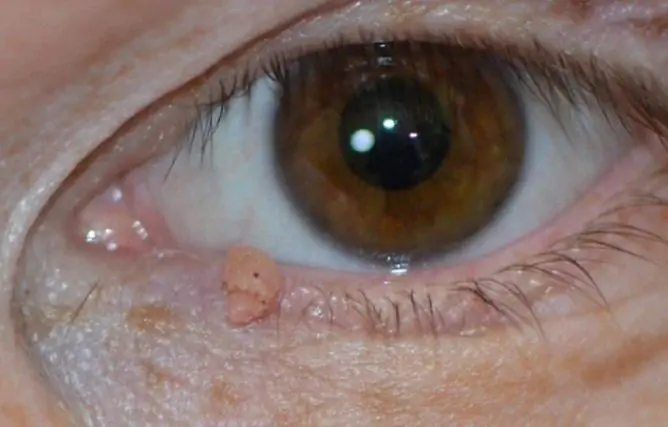- Author Rachel Wainwright [email protected].
- Public 2023-12-15 07:39.
- Last modified 2025-11-02 20:14.
Keloids

Keloids or keloid scars are abnormal growth of scar tissue in the area of injury, burns, surgery, infectious skin lesions or other violations of its integrity, significantly exceeding the size of the primary injury. The localization of keloids is different. Most often, keloids are formed in the area of the chest and shoulders, in the area of the earlobe, in functionally inactive areas of the skin. The severity of the injury does not affect the likelihood of a keloid, its size. Outwardly, keloids look like a dense tumor-like formation, towering 5-8 mm above the skin, pale or bright pink, bluish in color. The etiology of keloids is still unknown.
Keloids do not pose a danger to human life and health, however, they cause tangible physical and psychological discomfort (unaesthetic appearance of the keloid). The formation of keloids is accompanied by the following symptoms:
- Itching when scratching;
- Pressure pain
- Increased sensitivity of the affected tissues;
- Redness in the area of the keloid.
There are two stages in the development of keloids:
- The active stage is characterized by the dynamic growth of the keloid, which causes physical discomfort to the patient (soreness, itching, numbness of the affected tissues), at this stage it is customary to talk about an active keloid;
- The inactive stage is characterized by the complete completion of the formation of the keloid, the scar does not give the patient any special discomfort. Such a keloid is called inactive or stabilized, its color is close to the natural skin color.
Keloid begins to form after 1-3 months from the moment of wound epithelialization. The active growth stage can last more than 12 months. Typically, the keloid retains a firm consistency and does not shrink in size.
It is necessary to distinguish between keloids and hypertrophied scars, since it is the type of scar that will determine the further treatment tactics. A hypertrophied scar, unlike a keloid, is formed only at the site of skin damage, does not exceed the boundaries of the injury. The causes of a hypertrophied scar are inflammation during the healing process, the addition of a secondary infection, endocrine dysfunction, and a decrease in local immunity. The rest of the signs are similar to keloid.
If you experience the following symptoms, you should see a doctor:
- Strengthening of painful sensations both during mechanical action (pressure, friction of the scar), and in a state of relative calm;
- The appearance of signs of inflammation of both the scar itself and the adjacent skin areas;
- A significant increase in the keloid in a relatively short period of time.
Risk factors for developing keloids
The exact reasons for the formation of keloids are still unknown. There are factors that significantly increase the risk of keloid formation in humans, among which are:
- Genetic predisposition;
- Severe skin pigmentation;
- Certain localization of traumatic skin lesions (chest, earlobe, deltoid muscle region);
- Infection of the wound during the healing process;
- An imbalance in the immune system;
- Hormonal imbalance in the body;
- Age-related changes;
- Innervation disorder.
Keloids on the ears: etiology

Keloids most commonly affect the earlobe. One of the reasons for the formation of keloids on the ears is a puncture of the earlobe or cartilage, wearing earrings made of low-quality alloys that irritate the skin of the ear. Keloids on the ears cause not only aesthetic discomfort (the location of the keloid in a conspicuous place, the inability to wear jewelry), but also physical, since during the active stage of growth, the keloid can cause burning sensations, itching, pain, aggravated by mechanical action on the area (touching the scar while dressing, while sleeping). It has been suggested that piercing the earlobe with a pistol and placing the earrings on the screws promotes the formation of keloids on the ears. Currently, separate methods of treating ear keloids have been developed.
Keloid: treatment, conservative techniques
Among the methods of treating keloids, conservative and radical methods are distinguished. Regardless of the type of keloids, scar treatment is preferable to start with conservative methods, including:
- Compression is the application of pressure to the area of the skin affected by the keloid. Compression prevents the growth of the keloid, blocks its nutrition, compresses the vessels of the scar, which can lead to a stop of its growth;
- The use of silicone plates - the mechanism of action of this method of treating keloids is based on squeezing the capillaries, reducing collagen synthesis, reducing the delivery of inflammatory mediators, and hydration of the scar;
- Ointment therapy - this technique is additional and is rarely used as an independent type of therapy for keloids, treatment with ointments is based on the auxiliary effect of antibacterial, anti-inflammatory substances that normalize blood circulation;
- Corticosteroids - this technique is applied locally or by introducing a substance into keloids, the treatment of scars is based in this case on a decrease in collagen synthesis (inhibition of the division of fibroblasts that generate collagen, as well as an increase in the concentration of collagenase, an enzyme that promotes the breakdown of collagen);
- Cryodestruction - damage to keloid tissues, treatment is aimed at destroying the cytoplasm and cell organelles with cryogen. This technique allows you to completely remove the keloid. The advantage of this technique is the low likelihood of recurrent keloids;
- Cosmetic correction - various techniques (peels, dermabrasion) aimed at correcting the appearance of the scar.
Removal of keloids: aggressive treatments
Aggressive methods of treating keloids involve surgical excision of the scar tissue or laser burning of the scar area.
Surgical removal of keloids involves the removal of not only the tissues of the scar itself, but also the removal of the skin area on which the keloid has formed. The main disadvantage of surgical removal of keloids is the high probability of a new scar formation at the site of surgical excision. Removing an area of skin can reduce the risk of a new keloid forming. Relapses with surgical removal of keloids reach 74-90%. Surgical treatment of keloids is a necessary measure if conservative methods of treating scars have been ineffective.
Laser correction of a keloid allows you to remove (dissect and cauterize) the scar with minimal trauma to the surrounding tissues. Laser correction is used for the complex treatment of keloids (combined with local and injection corticosteroid therapy). In contrast to surgical excision, the percentage of recurrence of keloids with laser correction is significantly reduced and reaches only 35-43%.
With keloids, treatment with non-traditional means (traditional medicine), as well as self-medication, can aggravate the situation.
YouTube video related to the article:
The information is generalized and provided for informational purposes only. At the first sign of illness, see your doctor. Self-medication is hazardous to health!






